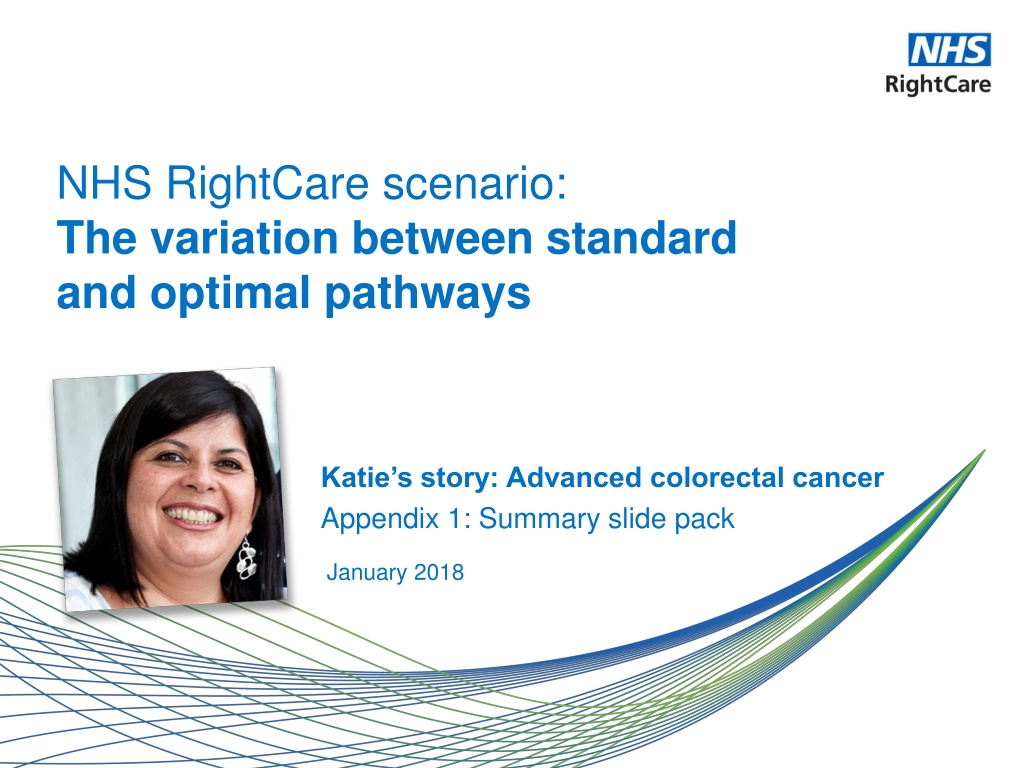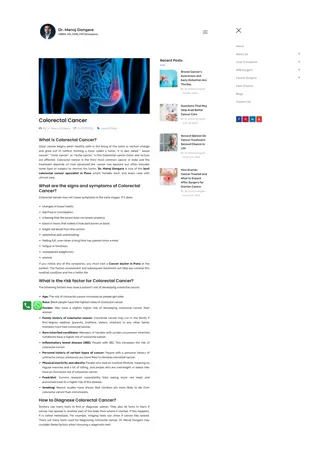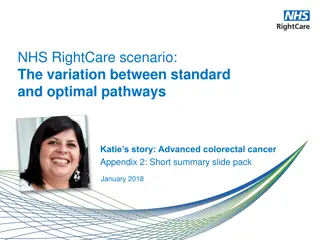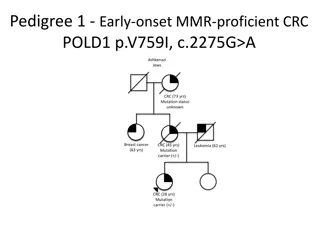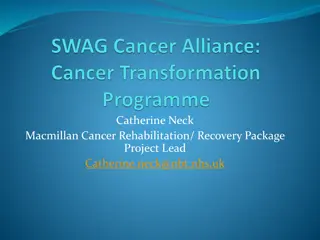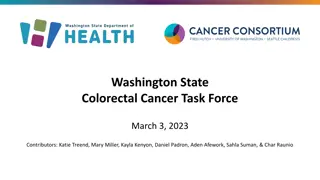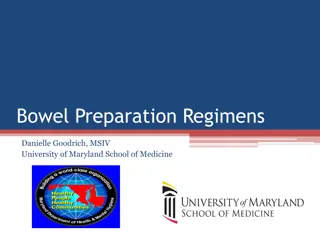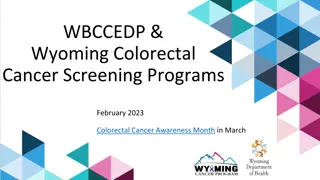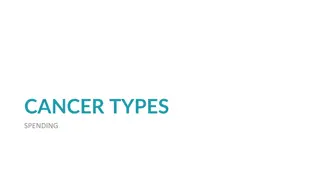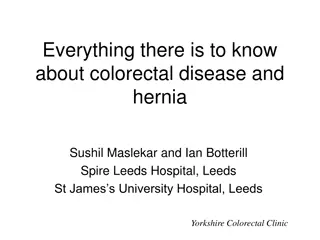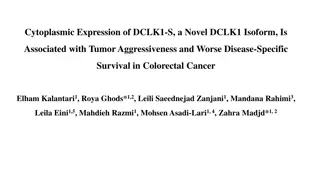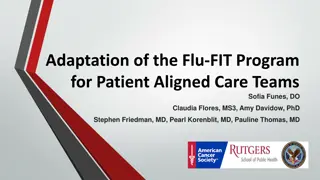Improving Care Pathways for Advanced Colorectal Cancer Patients: A Case Study
This case study highlights Katie's journey through an advanced colorectal cancer care pathway, comparing a sub-optimal scenario with an ideal pathway. It emphasizes the importance of utilizing NHS RightCare methodology to enhance outcomes and value in healthcare delivery. The narrative reflects the impact on patients and families, both in terms of quality of life and financial costs, underscoring the need for improved care strategies and support systems.
Download Presentation

Please find below an Image/Link to download the presentation.
The content on the website is provided AS IS for your information and personal use only. It may not be sold, licensed, or shared on other websites without obtaining consent from the author. Download presentation by click this link. If you encounter any issues during the download, it is possible that the publisher has removed the file from their server.
E N D
Presentation Transcript
NHS RightCare scenario: The variation between standard and optimal pathways Katie s story: Advanced colorectal cancer Appendix 1: Summary slide pack January 2018
Katies story This is the story of Katie s experience of an advanced colorectal cancer care pathway, and how it could be so much better At each stage we have modelled the costs of care, both financial to the commissioner, and also the impact on the person and their family s outcomes and experience. In this scenario we examine a colorectal cancer care pathway, comparing a sub- optimal but not atypical scenario against an ideal pathway. 2 1 4 3 It shows how the NHS RightCare methodology can help clinicians and commissioners improve the value and outcomes of the care pathway. This document is intended to help commissioners and providers to understand the implications both in terms of quality of life and costs of shifting the care pathway
Katie and the sub-optimal pathway (1) Katie is a 46-year-old retail worker. She lives with her husband, Isa and two young children Katie had surgery and adjuvant chemotherapy for colorectal cancer when she was 45. Scans clear at one year and the family moved county for husband s job Katie developed right upper quadrant pain persisted and became more severe over a month Waited two weeks for GP appointment saw GP twice and out of hours GP once over next two weeks Pain intensified ambulance took her to A&E where enlarged liver noted Admitted to surgical ward inpatient for three weeks. CT scan showed metastatic disease and she had liver biopsy. Katie was told the news on the ward whilst she was on her own, and had to break the news to Isa herself During this time, Isa took over childcare and was struggling, eventually getting sacked from his job Katie was referred to oncologist as outpatient: Palliative chemotherapy planned
Katie and the sub-optimal pathway (2) After first cycle of chemotherapy, struggled with pain and constipation: Visits to A&E and out of hours GP After further chemotherapy and inpatient acute care, follow up CT scan showed no response to chemotherapy and her liver function deteriorating: Chemotherapy discontinued The district nurse put in an application for the care package through continuing healthcare (CHC) but Katie s clinical condition deteriorated prior to this care being put in place Further admission to acute setting with bowel obstruction: Isa was told by the nurses that as Katie was terminally ill nothing can be done. Isa was told he should take her home to die. Katie said she did not want to die at home. Her preference was for a hospice if a side room was available. She did not want to discuss Advance Care Plans or decisions about Cardiopulmonary Resuscitation, or see the community palliative care team still struggling with situation Katie died at home in the end and the family situation was stressful and distressing in the extreme
Katie and the sub-optimal pathway Slow diagnosis Too late Care integration Traditional treatment Pathway flow not optimised Lack of patient choice Healthcare communication & patient education could be improved Too much reliance on acute care Devastating consequences Reactive rather than proactive Insufficient community care support Inappropriate care
Questions for GPs and commissioners In the local population, who has overall responsibility for: 1 Leading the Ambitions Framework and realising the DH Choice Commitment for the local system? 2 3 4 5 6 7 Ensuring the identification and registration of people with life-limiting illness on a locality register and multi-disciplinary meetings to optimise holistic care? Ensuring discussion, shared decision making & documentation of care plans? Implementing digital solutions including electronic palliative care coordination systems? Ensuring that care is personalised for the individual, including the offer of personal health budgets for people who might benefit from one? Ensuring commissioners utilise the suite of contemporary tools and guidance available aimed at reducing unwarranted variation and improving experience Involving patients in planning improvements in the care provided for people with advanced colorectal cancer and palliative care needs?
Katie and the optimal pathway (1) Katie and her family moved to their new home in January, having finished her chemotherapy for colorectal cancer a year earlier When registered, her new GP promptly referred her to a local nurse-led colorectal cancer follow-up clinic and forwarded her notes and images When she developed persistent abdominal pain a year later, Katie rang the colorectal nurse specialist directly this triggered the locally agreed pathway and a CT scan and bloods were organised MDT discussion took place following results of CT scan and then of liver biopsy. On each occasion, Katie was offered appointment at results clinic and opportunity to bring somebody with her Katie was given a double appointment in her GP surgery to allow time for questions and discussion. A personalised care and support plan was documented using the enhanced section of summary care records
Katie and the optimal pathway (2) Katie was seen by the enhanced supportive care service in hospital and palliative nature of the treatment plan and symptom management discussed. Community palliative care team and local hospice family support team supported Katie and her family at home Katie s pain settled so she was able to return to work part-time, undergoing two cycles of chemotherapy Follow up CT scan results showed that her cancer was not responding - Katie decided to stop chemotherapy Katie was introduced to the concept of a personal health budget and later used it to pay her neighbour to help with her care Towards the end (two months later than the suboptimal scenario), although Katie s care was not perfect (as a hospice side room was not available when she needed it), she and her family were well prepared and well supported Katie was able to die peacefully in hospital (importantly not at home) and the whole process was well managed, including the provision of family bereavement support
Katie and the optimal pathway Prevention Focus Right first time focus Efficient processes Appropriate Strong co- ordination between primary and secondary care MDT working Patient choice Shared decision making Support mechanisms in place Trusted system Happier and healthier experience Proactive education and communication Third sector engagement Proactive and great communication Great community care Great holistic care
Caregiver support The quality of life of a person with colorectal cancer and their family is deeply affected by the diagnosis, as a result of both the physical and psychological impact it has. Caregivers often provide uncompensated care, which is physically, emotionally, socially and financially demanding and results in the neglect of their own needs. It has been demonstrated that the psychological health of caregivers is often negatively affected, with reports of increased prevalence of both anxiety and depression. Recognising the needs of carers is extremely important, both for them and the person for whom they care, and has been shown to have positive effects on quality of life and quality of care. Information available for carers: www.carersuk.org www.macmillan.org.uk/information-and-support/audience/looking-after- someone-with-cancer.html
Financial information Analysis by provider Sub-optimal Optimal Optimal % Third sector 0 1,379 n/a Acute 18,467 4,978 27% Ambulance service Carer 536 0 0 n/a n/a 1,152 Community teams 321 3,732 1164% Patient 0 10 n/a Primary care Grand total 302 19,626 459 11,726 152% 59.7% Secondary care expenditure in the two scenarios is radically different. Acute costs in the optimal case represent only 27% of the original sub-optimal case (90% reduction in bed days) equating to a reduction of 13.5k. Community teams offer a great deal more support and a personal carer is also necessarily higher in the optimal scenario as the optimal case needs to invests in these areas to ensure Katie s care and support is as good as possible given this very difficult case. NB This also raises the importance of improved strategic budgeting across the wider health economy.
Financial information Analysis by cost category Sub-optimal Optimal Optimal % Community care Elective admissions Palliative and End of Life Prescribing and Meds Optimisation Primary care management Secondary care management Self care Urgent and emergency care Grand total 125 0 156 2,907 1,000 4,002 2333% n/a 2558.1% 88 117 17,719 0 1,421 19,626 491 384 2,902 20 20 11,726 559.5% 329.4% 16.4% n/a 1.4% 59.7% Not only is Katie s quality of care so much better in the optimal scenario, but the cost savings are also significant at 7.9k (40%). NB the financial costs are calculated on a cost per patient basis and local decisions would need to take a population view of costs and improvement. Plus chemotherapy costs (including drug costs) are the same in both scenarios. This is not a distinguishing variable in this study.
Further information For more information about Katie s journey, NHS RightCare or long term conditions you can: Email rightcare@nhs.net england.longtermconditions@nhs.net Visit www.england.nhs.uk/rightcare Tweet @NHSRightCare
